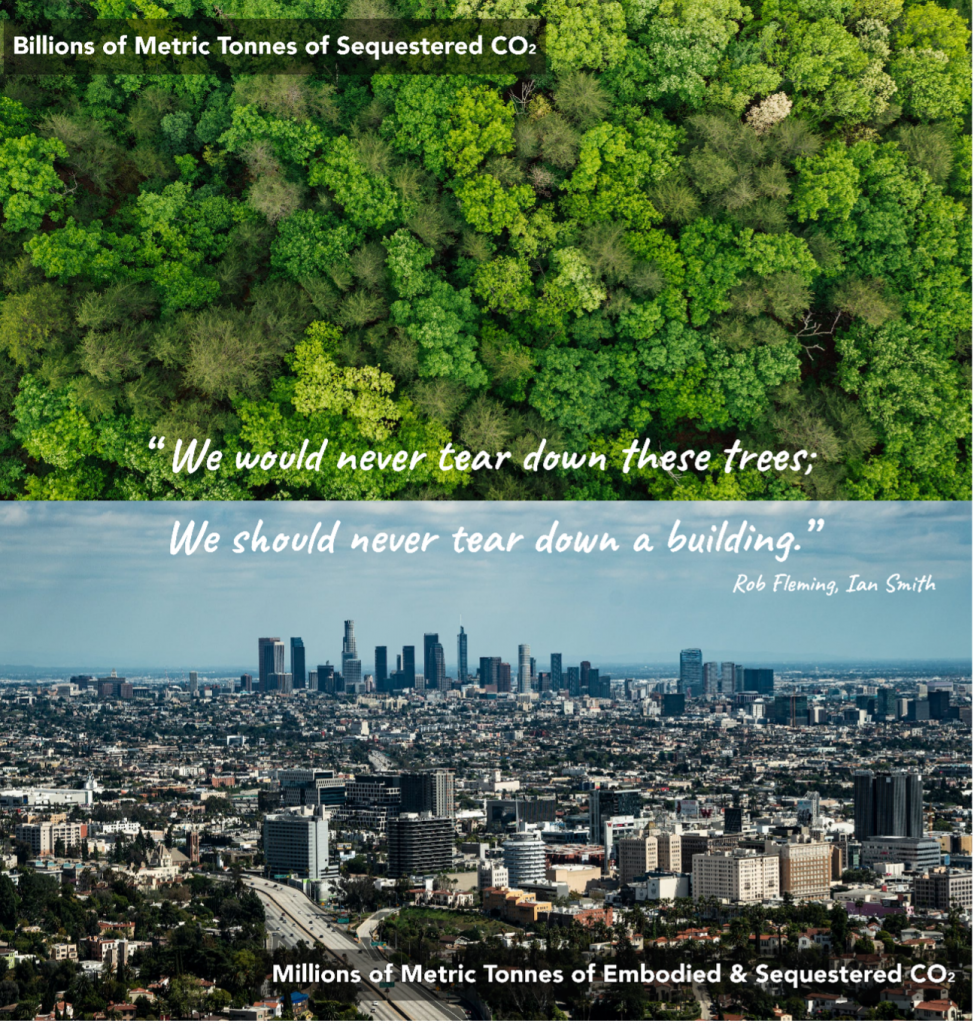by Surabhi Khanderia | Original article on the USGBC-LA blog

Written by Surabhi Khanderia
Sustainability Design Manager, LEED GA.
The concept of Buildings as ‘material banks’ is a paradigm shift in the way the construction industry views and utilizes the materials it employs. Rather than viewing buildings as disposable entities, this approach posits that buildings should be thought of as repositories of valuable materials that can be reclaimed and reused in future construction projects. This method of design, construction, and decommissioning of buildings plays a significant role in reducing the environmental impact of the construction industry.
Opportunities include:

Reusing existing buildings is a strategy for carbon avoidance, the first step in a holistic decarbonization strategy. Considered the most effective way to address climate change, it directly reduces the amount of greenhouse gases produced. Alternatively, offsetting merely compensates for these emissions and does not address the source of emissions.
Preservation Sustainability is a grassroots design movement that originated at Ian Smith Design studio in Philadelphia. It brings together principles of historic preservation, sustainability, and social equity. Acknowledging that each demolished building detracts from our history, our neighborhoods, and our climate. Preservation sustainability recognizes ALL buildings as ‘monuments to our culture’. It calls to penalize demolition and use the funds towards radical urban policies and new financial instruments to support historically disadvantaged communities. It calls for action today to preserve our past and protect our future.
Studio One Eleven, a leading architecture firm based out of Long Beach, CA was built upon creating more livable, sustainable, and engaging cities. Its founders began establishing its footing by revitalizing forgotten buildings and revitalizing through community culture and responsible design. Its portfolio boasts several preservation projects, including The Exchange at Bellflower, The Concord in Pasadena, and the first of its kind, Partake Kitchen in Long Beach, CA.
Partake Kitchen, is an adaptive reuse project that will serve as both a ghost kitchen and a public food hall. Initially constructed in 1942, the property is registered under LEED Gold for new construction and WELL Gold certifications with the goal of preserving all structural elements of the building while allowing for a full interior fit-out and replacement of mechanical, electrical, and plumbing systems. In total, 98% of the building’s total surface area, including the entirety of the exterior enclosure, exterior wall assemblies, and interior structural walls, were reused earning the project points for exemplary performance under the building and material reuse category of Material and Resources (MR) credits for LEED.
Leading Edge played a crucial role in the design and responsible material sourcing of products. Our team worked closely with Zero Envy to perform energy modeling and provided sustainable design guidance in the pursuit of LEED and WELL certifications. As in-house partners with leading national and international brands in architecture and real estate, we take great pride in our involvement in high-achieving projects that demonstrate our commitment to excellence.
Personally, my favorite feature of this building is the mural on the façade. The intricate design on the exterior of the building is a masterpiece written in the flowing script of the artist’s native language. The ingredients of the South Asian dish Dal, hidden within the art, are a secret waiting to be unraveled by those who take the time to appreciate its beauty! Each stroke and curve of calligraphy tells a story as if the façade itself is a canvas for a beautifully crafted culinary tale. The intricate details and vibrant color (inspired by the color of turmeric) dance across the surface, inviting onlookers to taste the rich history that is baked into every bite. “The art speaks to sharing cultures, your heart, and your home through food”, says Imagine, the muralist from Nepal.
Partake Collective, is a sustainable feast for the eyes and the tastebuds. The food collective satisfies not only our cravings but our conscience, proving that green design can be delicious! Bon Appétit!
